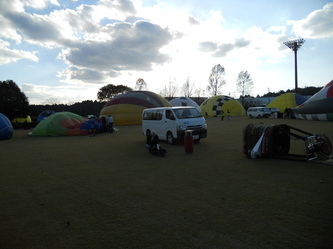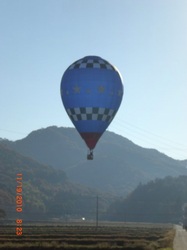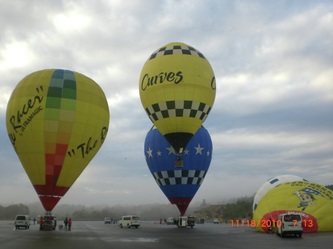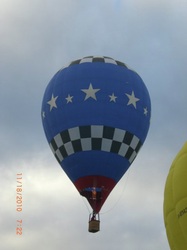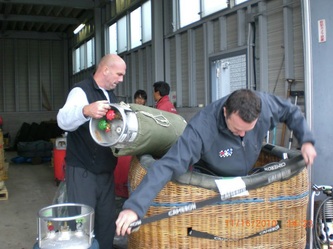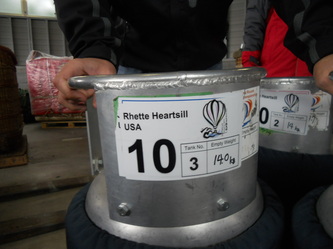Tochigi International Championship
tochigi japan
2010
Four Tasks Monday to Finish the ChampionshipMonday morning greeted competitors in Tochigi with what was likely the last opportunity to fly and four tasks. The ceilings were low and the wind had potential to get stronger as the morning went on. The weather sheet showed the clouds a couple of thousand feet up and slow winds. The four tasks were a FIT, PDG, JDG, and a FON.
The first task of the morning was a FIT to a target that the event has used a lot over the years. Usually, the competitors will approach this target from the west and then continue flying to the East-Southeast. This year continued its unusual course as competitors flew from South to North. All the pibal and wind data from the event showed that it would be fairly easy to make it to all the targets and it would be a matter of just flying to them accurately to determine the champion. However, once in the air the winds slowed down below the clouds and shifted. The dominate winds shifted West of North which created a big headache as the flight progressed. The FIT had some very close scores as the current leader Yoshimi Kodama of Japan flew right across the center with a .05m drop and second place Yudai Fujita had a drop near one meter. A big group of competitors missed the field to the left by a siginificant distance. The PDG proved to be a challenge as the pilots picked their PDG targets based on the winds before they took off and the winds to get to the JDG task. Pilots were allowed to select two goals for their PDG and most selected the same two. Yudai continued his own pursuit of the Championship by winning task 20 but was followed close by Kodama who also scored well with a high 900 point score to keep his grip on first place. The JDG was the most difficult task of the morning as competitors had to go very high to get some speed and turn to the right to get to the target. Six Japanese pilots went up and then almost immediately came back down just to give them a small push towards the target. Those Japanese pilots were hoping for the winds on the surface to switch around to the Southeast.....and that is just what happened. All six of those pilots had close drops and other pilots who flew further north banking on Southerly winds had drops outside of a kilometer. The FON was the last task of the event and it only had to be one kilometer from the previous mark. Yudai, exhibiting great patience, had a drop under a meter after flying for over an hour to get to this goal. All in all it was a good morning for competition. The single most important aspect of the week was scoring well or at least above average on the evening flights. There were six thousand points available in the evenings and if you could manage 4000 you could almost be guaranteed the win. The final standings showed former Japanese National Champion Yoshimi Kodama winning the event for the first time, Yuudai Fujita was second with his highest showing at this event and defending Tochigi champion Takao Mitzukami was third. Americans John Petrehn and Nick Donner finished 4th and 5th respectively. |
Links:
Official Event Site Results Motegi Weather FAI - World Air Sports Federation The three Flying Areas: Haga, Japan Utsunomiya, Japan Motegi, Japan Tochigi Local Time: |
On Board with Japan's Ryuji Nogami
.
.
On Board with American Johnny Petrehn
.
.
Sunday PM - Two More Tasks
Sunday afternoon pilots were greeted with a two part Hare and Hound (HNH) followed by a FON. There was actually some flow with the wind so there was no concern about not being able to get to all targets. The problem this afternoon was that the common launch point where the Hare balloon would launch was very close to prohibited zones where the balloons would be forced to climb to 1000 feet.
The Hare balloon launched at 3pm and a few minutes after that the green flag went up for the hound balloons to begin chasing. The first half of the field went to the left and the back half moved more to the right. As the flight went on the right began to go away below 1000 feet and everyone was just trying to hold onto what little left we had. Nick Donner was the first to go high and went up above 5000 feet in search for a turn to the right at over 30 kilometers per hour. No one else went up until after they were past the hair balloon as they tried to adjust for their FON. There were four pilots that got scores in the field of the HNH.
The FON will be anyone's guess. Some pilots forgot to put their FON coordinates on their HNH baggies and others picked good goals but the winds just went back and forth.
Pilots tonight will go to the Utsonomia field where they flew to this morning to put the balloons up after dark for a balloon glow. Weather looks to be more flyable than not for Monday morning but after that there is a prediction for 100% rain. Scores might shake up some still. Yuudai Fujita had a solid night from the looks of things.
The Hare balloon launched at 3pm and a few minutes after that the green flag went up for the hound balloons to begin chasing. The first half of the field went to the left and the back half moved more to the right. As the flight went on the right began to go away below 1000 feet and everyone was just trying to hold onto what little left we had. Nick Donner was the first to go high and went up above 5000 feet in search for a turn to the right at over 30 kilometers per hour. No one else went up until after they were past the hair balloon as they tried to adjust for their FON. There were four pilots that got scores in the field of the HNH.
The FON will be anyone's guess. Some pilots forgot to put their FON coordinates on their HNH baggies and others picked good goals but the winds just went back and forth.
Pilots tonight will go to the Utsonomia field where they flew to this morning to put the balloons up after dark for a balloon glow. Weather looks to be more flyable than not for Monday morning but after that there is a prediction for 100% rain. Scores might shake up some still. Yuudai Fujita had a solid night from the looks of things.
On Board with Japan's Ryuji Nogami
.
.
On Board with Japan's Ryuji Nogami
.
.
| flight_5.pdf | |
| File Size: | 18 kb |
| File Type: | |
| flight_6.pdf | |
| File Size: | 16 kb |
| File Type: | |
Saturday PM and Sunday AM bring six more tasks

Saturday afternoon competitors had a FIN and a PDG. Pilots could fly them in any order given the light and mostly variable winds. The pilots that flew to their PDG first and then attempted to get to the FIN had much better scores on the PDG and the competitors who did it the other way around did better on the FIN. There really wasn't much wind and two tasks was probably a bit aggressive and one would have been questionable.
Sunday morning brought five tasks. There was a FIN, PDG, JDG, FON, JDG. The flying line was basically set out by the Event Director through his task calling and brisk and variable winds on the surface made for some interesting scores.
The FIN was most pilots second task. There were 28 of 29 competitors scored by the measuring team there. Scores weren't very close but a lot of people were able to get to the field which will prove to be good enough to get a solid scores.
The PDG will be very competitive. Most pilots picked this to fly to first and anything outside of about 10 meters won't be very good.
The next JDG had 26 of 29 pilots being measured by the scoring team. Again getting to the field will prove to be very good here.
The FON probably had the best scoring of the day as there were about 6-10 baggies within 5 meters. The first four tasks were probably accomplished in about 45 minutes. The next 2 hours were spent flying between 4000 and 5000 feet at speeds around 6 kilometers per hour to get to the final JDG that was positioned 8.5 kilometers north.
The JDG had some great scores. Richard Sabin was about 1m on the gravity drop and Nick Donner was inside the legs of the X.
Standings should shake up some. Anyone who did well on 4 of 5 will definitely move up.
Sunday morning brought five tasks. There was a FIN, PDG, JDG, FON, JDG. The flying line was basically set out by the Event Director through his task calling and brisk and variable winds on the surface made for some interesting scores.
The FIN was most pilots second task. There were 28 of 29 competitors scored by the measuring team there. Scores weren't very close but a lot of people were able to get to the field which will prove to be good enough to get a solid scores.
The PDG will be very competitive. Most pilots picked this to fly to first and anything outside of about 10 meters won't be very good.
The next JDG had 26 of 29 pilots being measured by the scoring team. Again getting to the field will prove to be very good here.
The FON probably had the best scoring of the day as there were about 6-10 baggies within 5 meters. The first four tasks were probably accomplished in about 45 minutes. The next 2 hours were spent flying between 4000 and 5000 feet at speeds around 6 kilometers per hour to get to the final JDG that was positioned 8.5 kilometers north.
The JDG had some great scores. Richard Sabin was about 1m on the gravity drop and Nick Donner was inside the legs of the X.
Standings should shake up some. Anyone who did well on 4 of 5 will definitely move up.
On Board with Japan's Ryuji Nogami 11/21 Morning
.
.
On Board with American Nick Donner
.
.
On Board with Japan's Ryuji Nogami 11/20 Afternoon
.
.
Back in the Mountains for Four Tasks Saturday AM

Event officials called four more tasks Saturday morning in Tochigi, Japan. Tasks were a Fly-In Task (FIN), Judge Declared Goal (JDG), Fly-on (FON), Fly-on (FON). It was evident from the beginning that time was going to be a factor and that the tasks were going to require lot of work to achieve.
The Fly-in was about 35 kilometers (50+ km drive) to the east of the briefing center. The winds on the surface were to the southeast and as you went up they went around to the southwest. The interesting thing was that there is a large prohibited zone (PZ) just north of the goal. The upper level winds above 4000 feet were to the north. The competitors took off from the east and all away around to the south except for Yuudai Fujita who took off up the valley and followed it all the way down for a good score on task 7. There were several scores within the legs of the X and many more inside the field.
The next goal was the JDG and which was due north from the FIN. This task required all pilots to climb above 4000 feet to find winds that took them towards the JDG. The winds shifted slightly as most were descending and holding onto the left was c some could do. Great Britain's Mike Howard, did very well at this target while representing BalloonPong by flying one of our basket banners.
The FON goals were anyone's guess as to where to fly to. The faster winds were to the north but would require a climb back to about 4500 feet and if you stayed low the closet goal was not very close at all and would be difficult to get to. The American pilots (plus Mike Howard) went to a goal to the north and still ran out of time on task 9. The closest of the group to the target was Nick Donner with a score of about 160m. There are certainly better scores but there will also be far worse score this morning.
Things definitely tightened up a bit as the wind shifting on the surface had the American switching the last FON with under a minute to go. This goal was closer and more straight south than the goal they originally had intended going toward. Mike Howard bested the field most likely with a score around a meter followed by Nick Donner and John Petrehn right at 5m. There will be other close results on this task as well.
All in all it was a great morning for competition. Scores should be fairly tight on most targets and points made up on the leaders. This afternoon it is supposed to rain but it is currently sunny and everyone hopes for a competitive
The Fly-in was about 35 kilometers (50+ km drive) to the east of the briefing center. The winds on the surface were to the southeast and as you went up they went around to the southwest. The interesting thing was that there is a large prohibited zone (PZ) just north of the goal. The upper level winds above 4000 feet were to the north. The competitors took off from the east and all away around to the south except for Yuudai Fujita who took off up the valley and followed it all the way down for a good score on task 7. There were several scores within the legs of the X and many more inside the field.
The next goal was the JDG and which was due north from the FIN. This task required all pilots to climb above 4000 feet to find winds that took them towards the JDG. The winds shifted slightly as most were descending and holding onto the left was c some could do. Great Britain's Mike Howard, did very well at this target while representing BalloonPong by flying one of our basket banners.
The FON goals were anyone's guess as to where to fly to. The faster winds were to the north but would require a climb back to about 4500 feet and if you stayed low the closet goal was not very close at all and would be difficult to get to. The American pilots (plus Mike Howard) went to a goal to the north and still ran out of time on task 9. The closest of the group to the target was Nick Donner with a score of about 160m. There are certainly better scores but there will also be far worse score this morning.
Things definitely tightened up a bit as the wind shifting on the surface had the American switching the last FON with under a minute to go. This goal was closer and more straight south than the goal they originally had intended going toward. Mike Howard bested the field most likely with a score around a meter followed by Nick Donner and John Petrehn right at 5m. There will be other close results on this task as well.
All in all it was a great morning for competition. Scores should be fairly tight on most targets and points made up on the leaders. This afternoon it is supposed to rain but it is currently sunny and everyone hopes for a competitive
| flight_3_task_sheet.pdf | |
| File Size: | 18 kb |
| File Type: | |
| flight_4.pdf | |
| File Size: | 16 kb |
| File Type: | |
On Board with Japan's Ryuji Nogami
.
.
On Board with American Nick Donner
.
.
Variable Winds Challenge Pilots Friday Afternoon

As competitor friendly as the Friday morning flight was the Friday afternoon was just as unfriendly. Two Judge Declared Goals (JDG) were called and launch was required from a common launch area. As with most places in the World the winds in the afternoon are reasonably unpredictable.
The Friday afternoon flight proved difficult for pilots as there were not many scores inside measuring areas. A vast majority of the balloons missed the targets to the left by a considerable distance. Tonight there was a definite advantage to have a fat (non-racer) balloon in hopes that it would distort and climb right.
Lots of baggies were dropped from several thousand feet and it will be interesting to see just how many pilots return to the competition center with two baggies. Any pilot under 100-200 meters on both targets certainly had a great night.
Scores are posted. Several Japanese pilots took advantage of local knowledge that flying in your home country brings and were able to capitalize on the challenging evening flight. The current top three are Yoshimi Kodoma in the lead, followed by Takumi Takashima and Yoshikazu Ueda.
The weather officer has stated there is a chance of cloudy skies with rain in the morning. All of the competitors are hoping for steerable winds and a competitive task sheet to greet them for the Saturday morning flight.
The Friday afternoon flight proved difficult for pilots as there were not many scores inside measuring areas. A vast majority of the balloons missed the targets to the left by a considerable distance. Tonight there was a definite advantage to have a fat (non-racer) balloon in hopes that it would distort and climb right.
Lots of baggies were dropped from several thousand feet and it will be interesting to see just how many pilots return to the competition center with two baggies. Any pilot under 100-200 meters on both targets certainly had a great night.
Scores are posted. Several Japanese pilots took advantage of local knowledge that flying in your home country brings and were able to capitalize on the challenging evening flight. The current top three are Yoshimi Kodoma in the lead, followed by Takumi Takashima and Yoshikazu Ueda.
The weather officer has stated there is a chance of cloudy skies with rain in the morning. All of the competitors are hoping for steerable winds and a competitive task sheet to greet them for the Saturday morning flight.
On Board with Japan's Ryuji Nogami
.
.
| flight_2_task_sheet.pdf | |
| File Size: | 15 kb |
| File Type: | |
Excellent Start in Tochigi
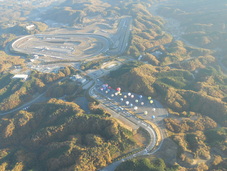
This morning at the Tochigi International Balloon Championship competitors were greeted with what could argueably be the best task calling of the year. The winds were brisk from 400-1000 feet but there was ample steering that allowed pilots to get to all four tasks.
Director Les Purfield called a Hesitation Walz (HWZ), Pilot Declared Goal (PDG), followed by two Fly-on (FOT) targets. The first two could be thrown in any order but the first FOT that the pilots could chose had to be declared from the PDG. Most if not all the pilots flew to the PDG first which might make some of the FOT scores on task three a bit interesting.
For the PDG, competitors could choose between two target options as opposed to the usual one. This was very helpful as the winds were a bit shaky on the first task and a lot of pilots flew to the second of the two options for this task. Their were a lot of good scores at the PDG with a few just centimeters off dead center.
The HWZ had most pilots going to the middle of the three target option. Most of the field scored on this task, including all of the Americans.
The two FOT tasks really split up the field as pilots declared their own goals using intersections as targets. The valley winds that most pilots chose their task 3 goal in had multiple wind layers within a few hundred feet of the surface that made for interesting steerage and good scores for some.
The right turn that had been very strong in early in the flight began to fad as pilots approached their declared intersection for task 4. Those that did well on this task were able to change their declaration on the tail of the task 3 baggie to adjust for the wind shifts. Its the small things in a competition that can end up costing a lot. On this final task, the Americans declared a goal with high powerlines forcing a high throw that limits accuracy.
Overall it was a very competitive morning. Scores here are generally posted quickly. Keep checking the results page throughout the day for updated scores.
Director Les Purfield called a Hesitation Walz (HWZ), Pilot Declared Goal (PDG), followed by two Fly-on (FOT) targets. The first two could be thrown in any order but the first FOT that the pilots could chose had to be declared from the PDG. Most if not all the pilots flew to the PDG first which might make some of the FOT scores on task three a bit interesting.
For the PDG, competitors could choose between two target options as opposed to the usual one. This was very helpful as the winds were a bit shaky on the first task and a lot of pilots flew to the second of the two options for this task. Their were a lot of good scores at the PDG with a few just centimeters off dead center.
The HWZ had most pilots going to the middle of the three target option. Most of the field scored on this task, including all of the Americans.
The two FOT tasks really split up the field as pilots declared their own goals using intersections as targets. The valley winds that most pilots chose their task 3 goal in had multiple wind layers within a few hundred feet of the surface that made for interesting steerage and good scores for some.
The right turn that had been very strong in early in the flight began to fad as pilots approached their declared intersection for task 4. Those that did well on this task were able to change their declaration on the tail of the task 3 baggie to adjust for the wind shifts. Its the small things in a competition that can end up costing a lot. On this final task, the Americans declared a goal with high powerlines forcing a high throw that limits accuracy.
Overall it was a very competitive morning. Scores here are generally posted quickly. Keep checking the results page throughout the day for updated scores.
| flight_1_task_sheet.pdf | |
| File Size: | 18 kb |
| File Type: | |
On Board with Japan's Ryuji Nogami
.
.
On Board with Johnny Petrehn
.
.
On board with Nick Donner
.
.
Practice Flight and Master Briefing

The Motegi flying area is dominated by mountains
Thursday, November 18, marked the beginning of the 2010 Tochigi International Balloon Championship. The practice flight this morning was from the Twin Ring Motegi area and the flight was to the south/southeast. Roughly 15 balloons made the flight in less than perfect conditions. Some balloons flew over 40 kilometers.
Pilot check-in was from 0900-1200 and followed by the Master briefing at 1300. At check-in they gave us a light saber (not kidding) and safety tool kit. Propane for recreational purposes is not supposed to be in enclosed trailers and therefore pilots have to have all warning stickers around the van and a bunch of instructions telling them how to fill up the tanks.
As part of the Master Briefing the power company came and performed a presentation asking pilots to please not hit the powerlines. One set near the Twin Ring Motegi apparently powers part of Tokyo and it would be bad if a balloon hit them. The powerlines here are often hidden in the hills an can be difficult to see.
This year the event has made it a big deal to remind teams about anti-doping rules and regulations within the FAI and the sporting code. They were quick to state that they would not be in charge of testing but it sounded like the Japanese government could test us for alcohol or drugs at anytime.
Roll call had 24 balloons showing up. This wasn't too odd as frequently local balloonists will show up after work on the day the master briefing takes place. Those pilots are not penalized for showing up late. This is a practice seems to work and as long as all obligations are met with the event there really shouldn't be an issue with those pilots.
The weather team (in rough English - the official language for all FAI events) stated that the outlook has been 'unstable' and is 'not easy' to predict. The forecast for the week currently shows that we should fly two flights on both Friday and Sunday but Saturday looks to have rain and wind. In addition, Monday afternoon might be windy. There is little to no chance of a flight on Tuesday morning.
Tonight there is a welcome party hosted in Haga town. This is a really neat event where local restruants come out and pilots, crews, and officials sample their food. There is usually WAY to much food to be had and everyone can find something to eat. Typically, local Japanese style dancing or playing of instruments are featured in an exhibition. it r
It looks like it will be important to fly well from the beginning. The chance of rain and unpredictable weather does not make it appear like you pilots can fly bad at the beginning and hope for more flights and tasks to move up in the rankings. Competitors to watch out for are certainly most of the international competitors including current world champion John Petrehn and runner-up Nick Donner. The locals to keep an eye on are defending Tochigi Champion Takao Mizukami and Yuudai Fujita fresh off his 3rd place at the Japanese National Championship two weeks ago.
Pilot check-in was from 0900-1200 and followed by the Master briefing at 1300. At check-in they gave us a light saber (not kidding) and safety tool kit. Propane for recreational purposes is not supposed to be in enclosed trailers and therefore pilots have to have all warning stickers around the van and a bunch of instructions telling them how to fill up the tanks.
As part of the Master Briefing the power company came and performed a presentation asking pilots to please not hit the powerlines. One set near the Twin Ring Motegi apparently powers part of Tokyo and it would be bad if a balloon hit them. The powerlines here are often hidden in the hills an can be difficult to see.
This year the event has made it a big deal to remind teams about anti-doping rules and regulations within the FAI and the sporting code. They were quick to state that they would not be in charge of testing but it sounded like the Japanese government could test us for alcohol or drugs at anytime.
Roll call had 24 balloons showing up. This wasn't too odd as frequently local balloonists will show up after work on the day the master briefing takes place. Those pilots are not penalized for showing up late. This is a practice seems to work and as long as all obligations are met with the event there really shouldn't be an issue with those pilots.
The weather team (in rough English - the official language for all FAI events) stated that the outlook has been 'unstable' and is 'not easy' to predict. The forecast for the week currently shows that we should fly two flights on both Friday and Sunday but Saturday looks to have rain and wind. In addition, Monday afternoon might be windy. There is little to no chance of a flight on Tuesday morning.
Tonight there is a welcome party hosted in Haga town. This is a really neat event where local restruants come out and pilots, crews, and officials sample their food. There is usually WAY to much food to be had and everyone can find something to eat. Typically, local Japanese style dancing or playing of instruments are featured in an exhibition. it r
It looks like it will be important to fly well from the beginning. The chance of rain and unpredictable weather does not make it appear like you pilots can fly bad at the beginning and hope for more flights and tasks to move up in the rankings. Competitors to watch out for are certainly most of the international competitors including current world champion John Petrehn and runner-up Nick Donner. The locals to keep an eye on are defending Tochigi Champion Takao Mizukami and Yuudai Fujita fresh off his 3rd place at the Japanese National Championship two weeks ago.
Teams arrive in Motegi for International Championships

The 2010 Tochigi International Balloon Championship will be held in the Tochigi province just west of Mito, Japan – about three hours by car North of Tokyo. The Championship will be spread out over a wide flying area to accommodate a number of logistics issues with the event. It is not often one region can provide three separate flying areas, but that is the case with the Twin Ring Motegi racetrack serving as the host for Thursday, Friday and Saturday mornings. The area around the racetrack provides a very unique flying area as balloons will take off in what is quite literally a small mountain range and usually fly north or east over the mountains (peaks do not exceed a couple thousand feet) and have at least one target that is in a valley. The valleys offer lots of challenges as the winds usually slow to a crawl and sometimes change every few minutes – making launch time critical. Drainage winds typically dominate the valleys for most of the morning, but not for the entire flight. Past the valleys are the flat lands, which have proven to be fairly predictable in the past.
Afternoon flights except Sunday will be held in the Haga town area West of Motegi. Haga will also host all the morning and evening briefings – making drives to the appropriate flying area a regular routine. Near identical intersections cover the landscape in Tochigi making it very difficult for pilots and crew to pick out exactly which intersection they have chosen for FOT’s (fly-on task) or PDG’s (pilot declared goal). The flights are usually hectic as winds shift all the way up to launch time and pilots can find themselves letting pibals go all over the map before deciding on a launch site. Taming the evening winds in the Haga flying area has typically been the key to bringing home a victory in Tochigi.
The final flying area to be utilized this week will be in Utsnomiya, which is located West of Haga. Utsnomiya is the most populated area pilots will fly in and generally speaking is the area where most pilots find hotels, meals, and other services.
All of the American contingent has arrived will be retrieving balloons tomorrow (Wednesday)morning that were shipped from Dallas. The four pilots representing the USA will be Richard Sabin, current World Champion John Petrehn, Nick Donner and rookie Rhett Heartsill. There are a total of 29 pilots from around the world, about ten are international. In addition to the international pilots the field includes the top three pilots from the Japanese Nationals held just two weekends ago in Saga.
The early weather looks to be a bit iffy for the week. Usually lots of sunshine greet teams and most if not all flights are flown. The weather forecast shows a chance for rain just about every day which will make it that much more important to fly well on any task that actually gets off. Event director Les Perfield will again call the tasks this year, his 5th consecutive time.
The competition starts Friday morning and continues until Tuesday morning with Tuesday evening as an additional flight window if two flights and four tasks have yet to be flown.
Keep checking back for pictures, videos and stories to come this week. Looking forward to a fun and competitive week.
Afternoon flights except Sunday will be held in the Haga town area West of Motegi. Haga will also host all the morning and evening briefings – making drives to the appropriate flying area a regular routine. Near identical intersections cover the landscape in Tochigi making it very difficult for pilots and crew to pick out exactly which intersection they have chosen for FOT’s (fly-on task) or PDG’s (pilot declared goal). The flights are usually hectic as winds shift all the way up to launch time and pilots can find themselves letting pibals go all over the map before deciding on a launch site. Taming the evening winds in the Haga flying area has typically been the key to bringing home a victory in Tochigi.
The final flying area to be utilized this week will be in Utsnomiya, which is located West of Haga. Utsnomiya is the most populated area pilots will fly in and generally speaking is the area where most pilots find hotels, meals, and other services.
All of the American contingent has arrived will be retrieving balloons tomorrow (Wednesday)morning that were shipped from Dallas. The four pilots representing the USA will be Richard Sabin, current World Champion John Petrehn, Nick Donner and rookie Rhett Heartsill. There are a total of 29 pilots from around the world, about ten are international. In addition to the international pilots the field includes the top three pilots from the Japanese Nationals held just two weekends ago in Saga.
The early weather looks to be a bit iffy for the week. Usually lots of sunshine greet teams and most if not all flights are flown. The weather forecast shows a chance for rain just about every day which will make it that much more important to fly well on any task that actually gets off. Event director Les Perfield will again call the tasks this year, his 5th consecutive time.
The competition starts Friday morning and continues until Tuesday morning with Tuesday evening as an additional flight window if two flights and four tasks have yet to be flown.
Keep checking back for pictures, videos and stories to come this week. Looking forward to a fun and competitive week.

